Lunch with…John Fitzpatrick
Not everyone's cut out for single-seater racing, which is no problem when your talent burns just as brightly in touring cars and endurance racing, as Fitz's did for over two decades
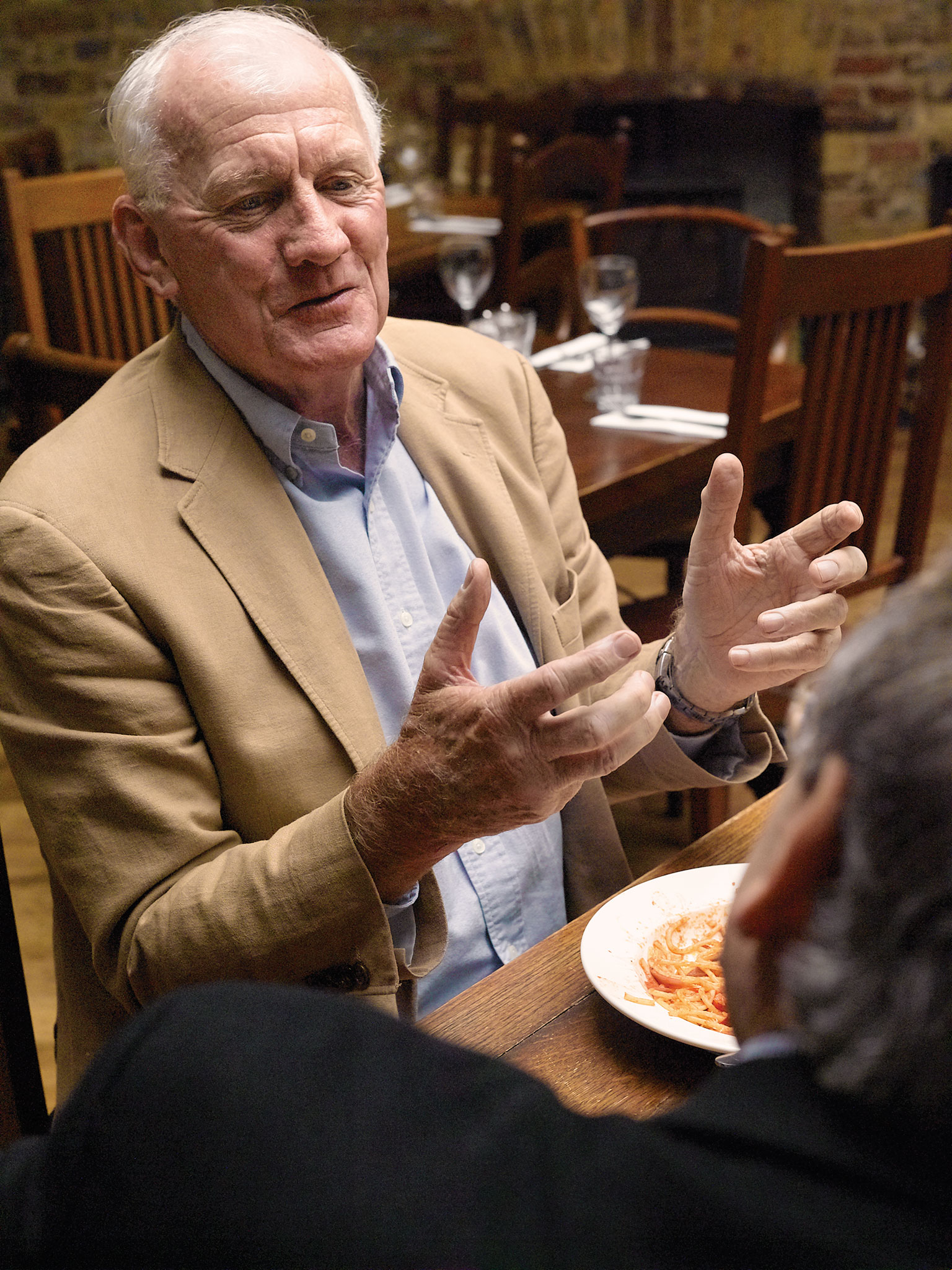
Talking through John Fitzpatrick’s long and remarkable motor sport career, two early dates stand out. One is May 19 1963, when a teenager in an 850 Mini won a saloon race at Brands Hatch outright, beating a lot of experienced drivers in more potent machines. Nobody could believe that the little maroon car was what its entry form said it was. “After I’d taken the chequered flag, as I drove into the pitlane I was met by the towering figure of BRSCC boss Nick Syrett, motioning me imperiously into the scrutineering bay.” The post-race strip proved the capacity to be precisely 848cc. The other date was early in 1965, when Ken Tyrrell — who’d watched Fitz in his second full season, now in a works Mini-Cooper — needed a replacement in his F3 team for Fl-bound Jackie Stewart. Fitz, now 21, was summoned to a rainy Goodwood to test an F3 Cooper. He wasn’t comfortable with it, and spun off. It was his first drive in a single-seater, and his last. Had that day at Goodwood been different, there’s no knowing how his career might — or might not — have developed. But now, with no single-seater ambitions to divert him, he was set firmly on the path of becoming one of the most successful touring car and endurance racers of his era.
Fitz hung up his helmet in 1983, but continued for three more seasons as an entrant. Since then he and his wife Sandra have mostly lived in Spain, but historic race rides bring him frequently to Britain. While he’s over to campaign a BMW CSL at Brands Hatch we meet at the Tufnell Park Tavern, a charming gastro-pub in North London. Fitz’s choice is cosmopolitan (linguine), English (bread-andbutter pudding) and American (diet Coke). He was born in 1943 in Erdington, Birmingham, where his father ran a business building truck bodies. “My boyhood ambition was to be a golf professional, but my father, who was a heavy smoker and had a friend who’d been killed on a motorbike, said: ‘If you promise not to smoke and not to ride a motorbike, I’ll buy you a car when you’re 17.” I stuck to that, and when my 17th birthday arrived in 1960 he bought me a new Mini. There was a pub in Sutton Coldfield where members of the Shenstone & District Car Club used to gather: Healeys and TRs in the car park, Midlands rally drivers like Ron Crellin propping up the bar. I joined the club, took the Mini’s hubcaps off, and did a sprint or two. One thing led to another, and I got a friend of my father’s to fit a second SU and a straight-through exhaust. 66 ne day in 1962, driving into Birmingham along the Stratford Road, I needed some petrol. At Sparkhill I pulled into a little garage with a couple of old pumps, and this chap in overalls came out and started filling me up. He noticed my straight-through exhaust and said, What you got there ?”It’s modified,’ I said proudly. I opened the bonnet to show off my twin carbs and flowed manifold. He took one look and said, ‘Load of f***ing crap. You’ll never get anywhere with that. Bring it in tomorrow and let me have a fiddle with it.’ That was my first meeting with Ralph Broad.
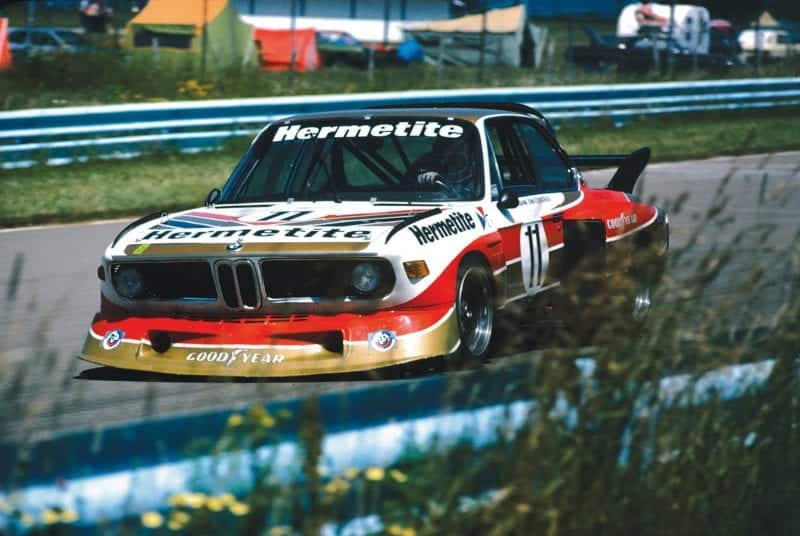
Hermetite BMW was shared with Tom Walkinshaw at 1976 Watkins Glen Six Hours
Motorsport Images
“When I picked the car up a few days later it went like the wind — and he refused to charge me anything. I did a few club races with it, didn’t get anywhere because it was still just a road car, but over the winter Ralph said, ‘Seems you can drive a bit. Why don’t we have a proper go at this?’ So we tore out the trim, got an old Cortina as a tow car, and Ralph made my Mini into a real rocket. We wanted it to look good, and there was a Rolls-Royce shade I rather liked, a metallic maroon called Regal Red. So we painted it that colour, with a silver stripe. Ralph was going to put the name of his little garage on the car, S.R. Broad 8,c Sons, but I said, ‘There’s Superspeed and Janspeed and all the other Speeds. Why don’t you call yourself Broadspeed?’ The name, and the colours, stuck.
“I had a lot of class wins with the Mini around the British circuits. That day at Brands, when I won outright, everyone was going berserk, saying my engine must be way oversize. They all crowded round in the scrutineering bay while Ralph, effing and blinding as usual, whipped the head off and they measured it. Exactly 848cc. Then for the last race of the day my friend Paul Layzell, who later became a big noise at BMW GB, couldn’t start his car, so I lent him mine. And he came first, beating all the Mini-Coopers. We’d won, stripped it down for the scrutineers, thrown it back together and won again. “After a race at Aintree John Whitmore, who was in the works Mini-Cooper team, said to me, ‘I’m leaving Cooper to go to Ford. If you like, I’ll drop your name to John Cooper.’ A few weeks later I was summoned to Cooper’s premises in Surbiton. In this grotty little workshop Phil Hill, the 1961 World Champion, was watching them build his next Fl car, starting from two chalk lines on the floor, and Bruce McLaren and Timmy Mayer were putting their Tasman cars together. I was taken upstairs to meet John and Charlie Cooper, and they said, ‘We need a driver for our Cooper-Mini team, number two to Paddy Hopkirk. We’ll pay £100 a race, you pay your own expenses. How old are you? 20? Get your dad to counter-sign the contract.’
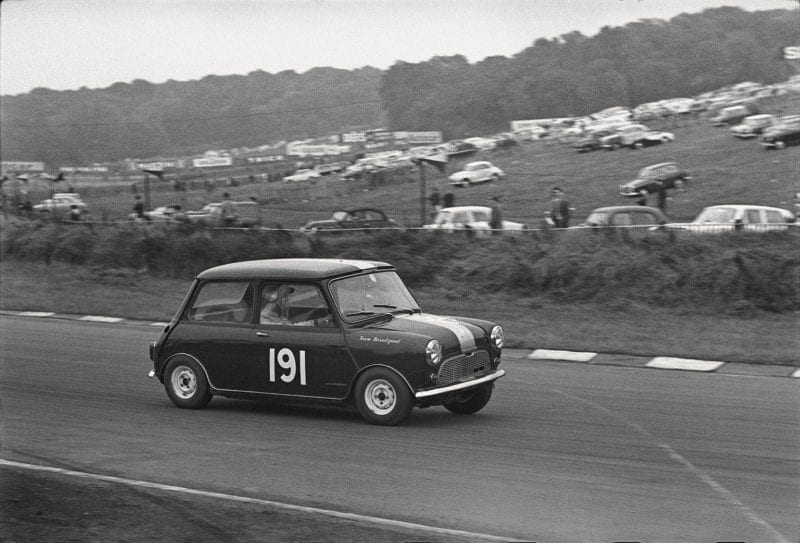
In 850 Mini, raced in 1963 and ’64
Motorsport Images
“Winning the British Saloon Championship was all about scoring points in your class, and Paddy couldn’t do all the races because of his rallying commitments, so if we were close he was meant to let me win. He didn’t like that much. At Silverstone he was determined to show who was quickest, and leave it to the last lap to back off and let me past. Unfortunately he got the lap count wrong and was still leading when a whole gang of us came streaming through the old Woodcote completely flat, door handle to door handle, to be greeted by the chequered flag. So he lifted off and we all went everywhere trying to avoid him — but the timekeepers reckoned he still beat me by a fifth of a second. Over the season I was class champion, but overall I was second to Jim Clark in the Lotus-Cortina. Of course Jimmy was a huge hero of mine, and suddenly I’m on the grid with him and he’s one of the lads, laughing and joking. When we had the 1275 engine for the first time, he came up behind me in practice. I waved him by — and coming out of the next corner I hung onto him for quite a way. Afterwards he came rushing over: ‘What on earth have you got in that thing?’ “Another time I was testing a Mini at Goodwood, hit a puddle at Madgwick and went straight into the bank. Jimmy was there testing an Elan. I don’t remember much about it, but I’d banged my head on the rollbar and was wandering around on the verge in a daze. Jimmy stopped at the Cooper pit and said, ‘You’d better go and scoop up Fitz, he’s trying to commit suicide.”
While Ginger Devlin looked after Cooper’s British challenge, Ken Tyrrell was running the works Minis in the European series with Warwick Banks and Julien Vernaeve. “When the British rounds didn’t clash I’d do the European events as well. In the Nurburgring Six Hours I shared with Julien and we were sixth overall. Ken was a father figure: strict, you had to do as you were told, but wonderfully encouraging, very good at giving you a boost.
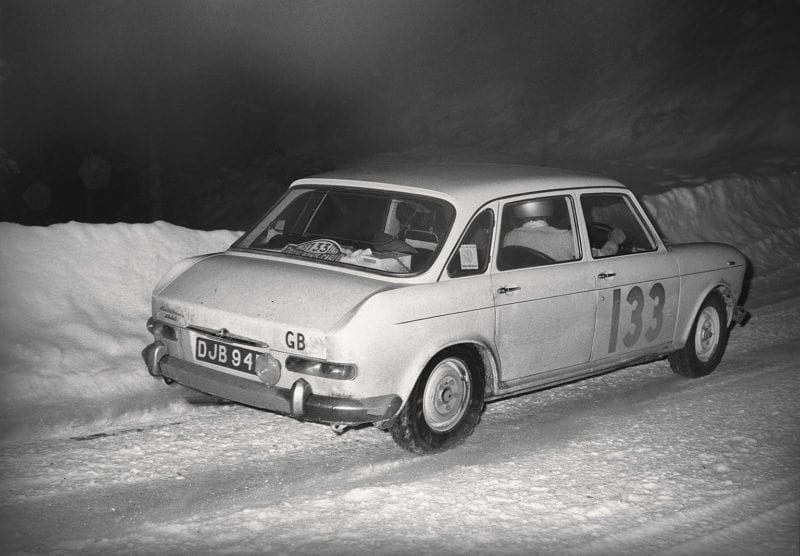
Fitz made rare rally outing on Monte Carlo in 1965 in Austin 1800
Motorsport Images
“Things had been going well for me, and at the end of the season Ken said, ‘Do you want to be a Grand Prix driver?’ I said, ‘Of course I do.’ So he said, ‘Come to Goodwood next Tuesday. We’ll put you in the F3 Cooper, and if you go well you can race it at the Easter Monday meeting in April.’ It was my big chance. It had been raining and the track was still wet. I’d never driven an open-wheeler before and it felt very odd. If I’d started off in single-seaters it wouldn’t have been a problem, but in a saloon you always imagine the front wheels are pointing in the right direction, whatever you’re doing with the wheel.
“Suddenly I was looking at how much lock I’d got on. My times were reasonable, but coming out of the chicane I got a wheel on the kerb, spun backwards and glanced off the bank. Afterwards Ken said, ‘Don’t worry about it, there’s no damage,’ but! had to be honest with him. I said, ‘I didn’t really like it. I couldn’t feel what the car was doing.’ That was it, it stopped right there. I never drove a single-seater again. “At the other end of the spectrum I did the Monte Carlo Rally in, of all things, an Austin 1800. I’d done a bit of rallying before, but never on snow and ice, and that year there was heavy snow. But we got to Monte Carlo in 27th place. On the final section in the Gorges du Cians the brakes failed completely, and we went off the road high in the mountains.
“The car finished up balanced on top of some concrete posts, teetering over the edge. It was pitch dark, and I didn’t know whether the drop was 30 feet or 300 feet. As my navigator Raymond Joss and I sat there wondering what to do, it toppled over. Fortunately the drop was only about 60 feet. It landed on its roof in a river, with us hanging in our belts. We scrambled out, and by the time we’d climbed back up to the road in the dark, cold and soaking wet, it was 4am and the road was deserted. So we started to walk. Towards dawn a Deux Chevaux came along, a local butcher on his way to market. He took us into Monaco and dropped us, shivering and exhausted, at the Tip-Top Bat “For 1965 I was back at Broadspeed, mainly doing European races, but in the British series my job was to stop the Superspeed Anglias taking points off John Rhodes in the works Mini.
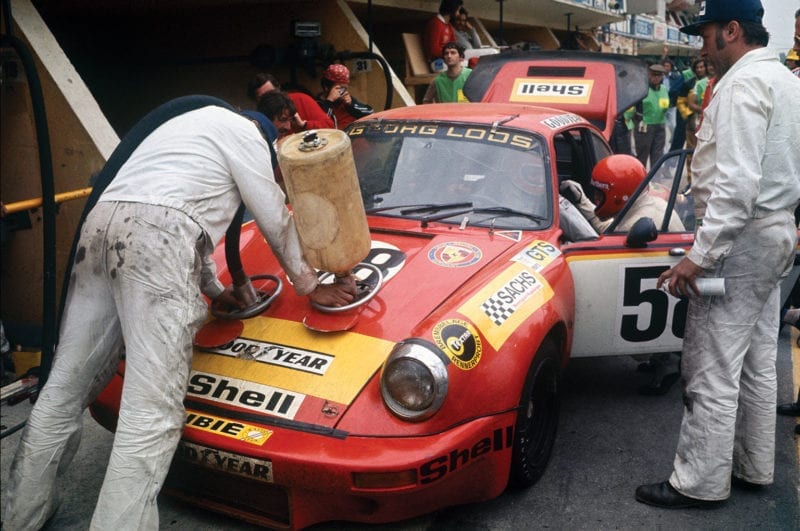
Loos Porsche was fifth overall at Le Mans in 1975 and GTS class winner
Motorsport Images
“At Oulton Park Ralph said to me, ‘Don’t worry about Rhodes. Just go like hell, and on the last lap out in the bushes just back off MD and let him win the class.’ I was miles in front, fourth overall behind the Mustangs and Frank Gardner’s Lotus Cortina, and on the last lap I’m looking in the mirror, where the hell is Rhodes? I’m going slower and slower as I turn into Druids when suddenly he’s coming up on the inside. I swerved wide to let him through, got on the marbles, and went end-over-end down the bank.
“Because Ralph’s cars were always so fast and so perfectly turned out, Henry Taylor at Ford offered him an irresistible deal to switch allegiance from BMC. So for 1966 I was in a two-car team of Anglias with Peter Proctor. At the Easter Monday Goodwood Peter had his dreadful accident and was badly burned, and after that Anita Taylor, Trevor’s sister, joined the team. She was right on it, just as quick as I was around Silverstone. That year I won the class in the championship again, and this time it was enough to take the overall British Saloon title.
“Ralph’s preparation was utterly fanatical, he was meticulous down to the last detail. You’d practice at some circuit on Saturday, put it on pole, everything going perfectly, the car flying, and then Ralph would say, ‘Right, load up, back to the f***ing workshop!’ Overnight he’d have the head off, doing all the valves, never satisfied, and bring the car back to the circuit at dawn for the race on Sunday.” spare weekends Fitz found himself being offered rides in other people’s sports cars — a Dutch Porsche Carrera Six, a brace of Ferrari 250LMs, Bill Bradley’s Porsche 910 (with Alan Rollinson, second in the Barcelona Six Hours to a GT40).
“At the Niirburgring Six Hours, after my Mini broke in practice, I was offered a drive with Rolf Stommelen in a works Fiat-Abarth. It was the first time I’d met Rolf, who was to be a friend, and later team-mate, right up to his death. Then Abarth offered me and Alan Rees rides in the Snetterton 500Kms, alongside Giancarlo Baghetti and Johannes Ortner. When I got to Snetterton I discovered the Fiats had no seat belts — they weren’t mandatory in those days — so I drove into Thetford and bought a full harness, and told them to put it in. I advised Alan to do the same, but he said, ‘I don’t need belts,’ went out in practice, rolled it up into a ball and broke several ribs. It poured with rain in the race, and I knew Snetterton better than Ortner and Baghetti, so I won the class and was sixth overall. “I carried on with Ralph in Anglias and then Escorts into the 1970s, winning my class in the British Saloon Championship, and doing races in Europe as well as in the Cologne cars run by Jochen Neerpasch. I won at Salzburg on Easter Sunday in the Cologne Escort, then flew back to drive Ralph’s Escort in the Easter Monday Thruxton meeting. I had to start from the back as I’d missed practice, but after two laps I was second to Brian Muir’s Camaro, and took a big chunk off the lap record. Then a stub axle sheared in the flat-out sweeps around the back and gave me a high-speed trip into the boonies.
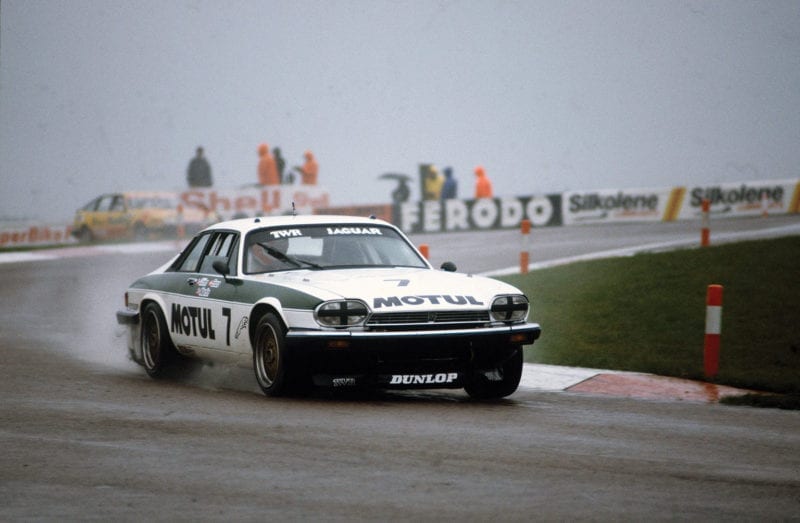
Fitz shared the winning Walkinshaw Jaguar XJS at 1983 Donington 500
Motorsport Images
“Frank Gardner was in the Alan Mann 1600 Escorts while I was in Ralph’s 1300 versions, and he became a close friend. A fantastic man. Even playing golf together I picked up little life lessons from Frank all the time, and of course he was a brilliant engineer. And on the track he never gave an inch. At Brands in October ’71 he was in Adrian Chambers’ big Chevy Camaro, I was in a 1600 Broadspeed Escort, and we both started from the front row. He powered into the lead, I caught him in the corners, then every time we got to a straight he’d be gone again. I sat there thinking about it, and I worked out that if I hung back at Dingle Dell I could go through there maybe 20mph quicker than him, get him under braking for Stirlings, then drive down the right-hand side of the road through Clearways and stay ahead to the line.
“Well, it all worked fine: we went into Stirlings with me just ahead, and I knew I had to stay in tight because no way was he going to yield. But as we came out of the corner my rear wheel and his front touched. I cartwheeled end-over-end halfway to the bridge. He spun and crashed backwards into the concrete bridge support. I got myself out saying aloud, ‘Bastard, bastard.’ I looked down the road and there was the Camaro in a cloud of smoke, much shortened, with Frank climbing out. And I started to laugh. Despite my full-face helmet Frank realised I was laughing, and he started to laugh. Gerry Birrell, who was next up in his Capri, came through and he was laughing too, because now he was going to win the race.
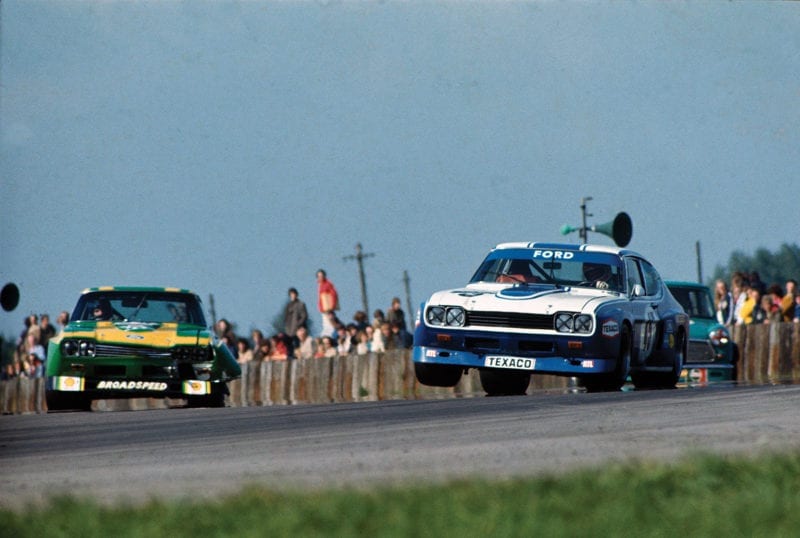
Cologne Ford Capri at 1973 Tourist Trophy
Motorsport Images
“I went over to Frank, still laughing, and Frank said in his deadpan way, ‘We’d better get our stories straight, Fitz, because Ralph and Adrian are going to go spare about this.’ There were certainly some choice expletives from Ralph when he saw us walking in together. “At the Daytona 24 Hours in 1972 I shared an Escort with Canadian rally star John Buffum, and the Kremer brothers were in the next pit, Manfred the engine guru and Erwin the driver and front man. During the long cold Florida night we got talking, and Erwin suggested I should drive a 911 for them. In April I did the first round of the European GT Championship, 14 laps of the full Nurburgring. Put it on pole, had a gearbox problem in the first leg and finished third, and in the rain in the second leg I walked it.
“The Kremers were happy with that, so I stayed with them for the season, won the class in the Niirburgring 1000Kms, won at Monza and Estoril, and won the GT Championship. I was also driving in touring cars for Schnitzer BMW with Rolf Stommelen — we won the Niirburgring Six Hours together — and Niki Lauda, who’d just started in Fl with March. Already Niki was sure he’d be World Champion, there was no question in his mind.” the 1970s Fitz continued to be one of Europe’s busiest professional drivers, racing in Porsches for Kremer and Georg Loos and in touring cars for Ford and BMW, and steadily clocking up wins and podiums. He won the lucrative season-long Porsche Cup three times, to add to his two European GT titles, and at Le Mans in ’75 his Loos Porsche was fifth overall and GTS winner. He was also a regular at the Bathurst race in Australia, winning it in 1976 with Bobby Morris in a Holden. Among a multitude of co-drivers, one he remembers fondly is the Scot Gerry Birrell: “We drove together in the Cologne Capris, sixth overall in the 1973 Niirburgring 1000Kms, and we easily won our class.” Four weeks later Gerry died in his F2 car at Rouen.
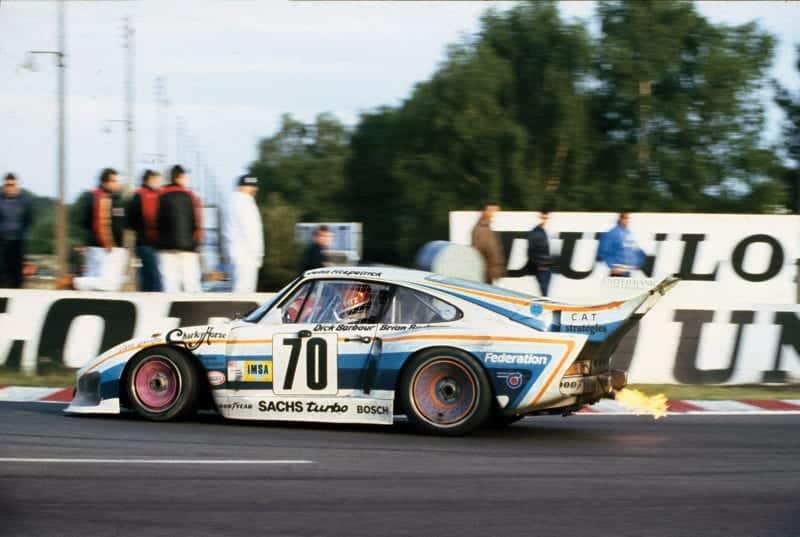
Successful 1980 with Dick Barbour included Le Mans win in Porsche 935
Motorsport Images
“In 1976 I was driving the Hermetite BMW with Tom Walkinshaw, but he couldn’t make it to Kyalami, so Ronnie Peterson did it with me. I’d spent a lot of time with Ronnie, we were friends, but we hadn’t shared a car before. He said, ‘It’s your car, you go out first, set it up as you like it.’ So I did a lot of laps, set a time, and came in. Ronnie went out, did four laps, equalled my time, came in. ‘Seems fine, don’t change anything.’ But I made a few set-up changes, did more laps, worked hard, went a little bit quicker.
I said to Ronnie, ‘I think you should try it now.’ He did two flying laps, equalled my time, came in again, ‘It’s fine. Don’t touch a thing.’ He was the ultimate natural, didn’t even want to adjust the seat. We were leading when the fuel tank split. “My father wasn’t into racing, but that year he came to the Niirburgring to watch me drive the
Hermetite BMW. Ronnie was in the Alpina car. After practice Ronnie said he knew a nice restaurant about 25 miles away, and we piled into his CSL road car, me in the front, my dad in the back with no seat belt. Ronnie was going along these twisting forest roads like it was the first lap of the race, sideways, opposite lock, the lot. He always drove like that on the road. My father, who’d never even heard of Ronnie Peterson, was completely shell-shocked. He had no idea anyone could make a car do such things. “In 1977 British Leyland asked Ralph El)
Broad to turn the Jaguar XJ12 coupe into a racing car. It was all dreadfully rushed: the cars raced a year too soon because BL insisted on it. When they were running they were fabulously quick, but Ralph was having to do all the development on the hoof. And they were very heavy, punishing the brakes and the hubs. At the Nurburgring we blew up engine after engine in practice, but one held together long enough for me to put it on pole. Ralph decided I should go flat out to put on a show, and Derek Bell and Andy Rouse in the other car should go as slowly as possible and try to finish. From the rolling start I broke the lap record on the first lap, came round all on my own, and going into lap two the oil pressure disappeared and I had to switch off. Derek and Andy cruised gently and managed to keep going to take second. I did eight races in the XJ12, with Tim Schenken as my co-driver, and we retired every time — apart from Brno, where a rear tyre exploded when I was doing 170mph. It took an hour to mend the damage, and we struggled home 16th with a sick engine.
“I drove again for Jaguar in 1983, with Tom Walkinshaw in the XJS. You had to admire Tom: he got tremendous loyalty out of his people, paid well, kept all the balls in the air. The only problem was, when you drove for him you knew things weren’t entirely kosher. It never occurred to me to cheat in my own team, and Porsche were the same, they’d never, ever cheat. In the XJS Martin Brundle and I won the Donington 500Kms, and Tom and I were third at Mugello. By then I knew we were cheating. I just thought it was wrong, so I didn’t drive for him again. How often you stopped for fuel was critical, and
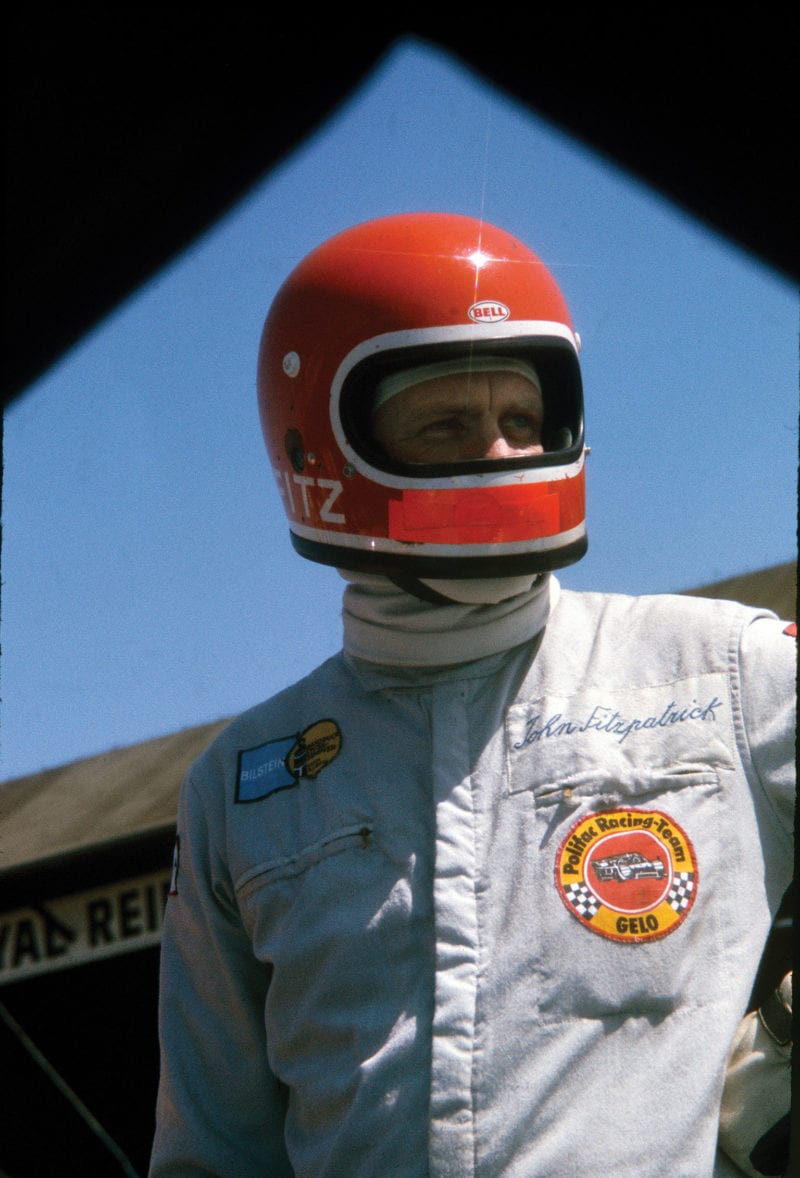
Fitz’s professional career lasted 22 years
Motorsport Images
“I think Tom found a way of switching the fuel allowance between cars, and using the vent bottle on the second filler to put in more fuel. Eventually the organisers twigged it and monitored fuel per car rather than per team. “It was Dick Barbour who persuaded me to go and live in America. He hadn’t forgotten the Watkins Glen Six Hours in 1978, when I was driving the Loos Porsche 935 with Toine Hezemans, and Stommelen was driving Dick’s 935. Toine comes in for the final stop to hand over to me, opens the door too soon and when he hits the brakes the door flies off its hinges. They shove me in, tape the door back on somehow and I’m gone, chasing Rolf for the lead. I catch him and I’m just working out my next move when, bang, the door flies off. I slipstream him down the straight and we go into the corner at the end side by side, I’ve got no door and his wheel is right here, grinding away at the plastic sill by my elbow. I got past him and
we won the race, but it was all a bit frantic. “For 1980 Barbour had big plans, ordered a new Kremer 935, and offered me a five-year deal. Sandra and I took the plunge, sold up everything in the UK and moved to San Diego. I won almost everything: the Sebring 12 Hours, Riverside, Laguna Seca, Sears Point, Portland, Mosport, Road Atlanta, and the 250-miler at Daytona. Dick was still doing a bit of driving, but he wasn’t really quick enough, so at Sebring, for example, he did two one-hour stints and I did the rest. I trained all the time then, so I had the stamina. In the 935 you didn’t have the g-force problem, but when the 956s came in, that was when you found you couldn’t hold your head up in the corners, and you had to do a lot more training for your neck muscles.
“But Dick’s dealerships weren’t going so well, and his five years turned out to be one year. I had some good offers for 1981, but I decided it was time to start my own team. I rented premises in San Diego, bought a truck, and took on two New Zealanders who’d been with Barbour, Max Crawford and Bruce Jenner. I bought a 935 off Kremer, and I had sponsorship from Sachs. But things didn’t go so well. I won Road Atlanta and Riverside, but we had a lot of turbo problems. Then Sachs cut back, and I’d spent a lot more than just their money. I needed another sponsor; badly. For the November IMSA finals at Daytona the new engine I required would be $100,000, and I decided not to go.
“Then, out of the blue, I had a call at the workshop. ‘Mr Fitzpatrick, my name is Jerry Dominelli. I love Porsches, I love racing, I’d like to get involved. Come and see me at my office in La Jolla.’ I was sure he’d be a time waster, but I went because you should always be courteous. It was Saturday morning, he was sitting in a big suite of offices, a very quiet guy, about 50, expensive suit, silk tie. I told him I wanted to do IMSA the following year but I hadn’t got the budget yet. ‘And Le Mans?”Well, to do IMSA and Le Mans, that’s got to be a couple of million dollars.”0K, John, let’s do it. When you get back from Daytona, come and see me and we’ll get it planned.”Well, I’m not going to Daytona, because I need a new engine.’ Of course you must do Daytona, John,’ and there and El) then he wrote out a cheque for $100,000. I still thought it was all bull, but on Monday morning I went to the bank, and the cheque was good.
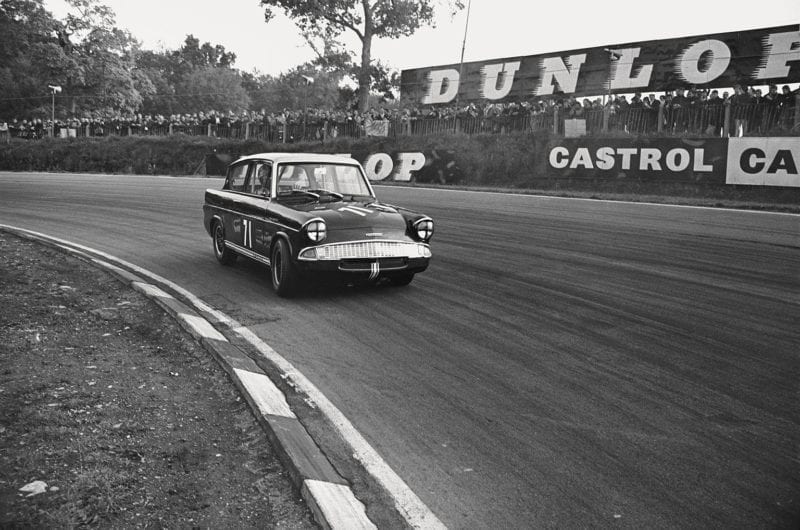
Fitz won the 1966 British Saloon Car title in Ford Anglia
Motorsport Images
“I went to Daytona, and when I got back I asked around about Dominelli. Everybody in San Diego with money to invest was raving about how much he was making for them. So I sat down with him and we planned the new season. We bought the ex-Wollek tube frame K4 from Kremer, and we started winning again. For Le Mans we knew the K4 wouldn’t be so good aerodynamically, so I got Joest to build us a replica of the Moby Dick 935. David Hobbs drove with me, the works 956s finished 1-2-3, and we were fourth and won the IMSA class. “Dominelli was in his office at Sam every day, when Wall Street started up in New York, and he’d be there until 10 o’clock at night. His brand, J David, was on the cars. In return for the funds he put in, he took 50 per cent ownership of John Fitzpatrick Racing Inc. Over three years he put in millions: at once stage we had three 956s. I never took a penny out of the team or his sponsorship, I just kept any prize money. Sandra and I invested a bit with him, and it all seemed very good: he sent you regular statements which showed you’d made two per cent one month, one per cent the next month, three per cent the next. 46 uring the Dominelli years, 1982/83, we won a lot of races in America and Europe. But now we have to talk about Rolf
Stommelen, which is still difficult for me. Rolf was the quickest driver I worked with. Most of us — Bob Wollek, Schenken, Hezemans — were evenly matched, but you always knew Rolf would be quick. At Riverside in April 1983 he was driving our Moby Dick, a slow car moved over on him and he spun avoiding it and kissed the bank. He carried on, but a rear wing strut had been damaged, and on the next lap at the end of that long 200mph straight the wing flew off. The car wrecked itself against the barriers. The remains were the right way up when I came round in the K4 and they were working on him. I carried on and won the race, sharing with Derek Bell and David Hobbs. They told us Rolf was OK but had a broken leg. It wasn’t until an hour later that they told us he’d had a heart attack in the ambulance, and he was dead.
“It was dreadful. The team carried on: I drove both our 956s at Le Mans — one retired early on but the other, shared with Rupert Keegan and Guy Edwards, was fifth — and Derek Warwick and I won the Brands Hatch 1000Kms in pouring rain, beating Ickx/Mass and Bell/Bellof in the works Porsches. But Sandra, who’d been very close to Rolf and his wife, was increasingly unhappy about my racing. Then at the end of the season, at Fuji, I had a big accident in practice. You get up to 180mph on the long straight there, and I was leading Bell’s works Porsche into the flat right-hander when the left front tyre exploded. I went straight on, hit the bank, up in the air, and Derek went underneath me. The remains of my car landed on its wheels and, apart from seat belt bruising, I was OK. But it had been 22 seasons, and I’d done a huge amount of racing mileage, more than any Fl driver. It seemed the right moment to stop.
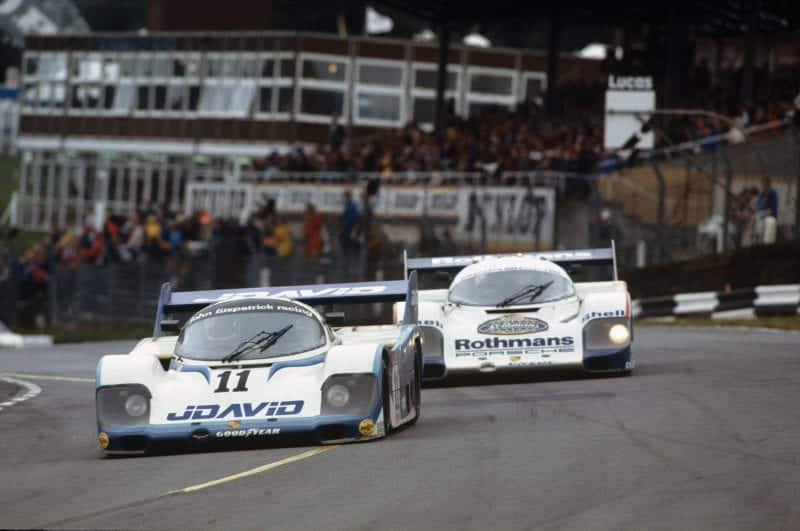
In Porsche 956 at 1983 Brands Hatch 1000km. Fitz/Derek Warwick beat Ickx/Mass works entry
Motorsport Images
“John Fitzpatrick Racing continued, because that was my business. Dominelli now wanted to do the Indy 500, so I ordered three Marches and five engines. One morning I went to see Jerry in his office early, as I often did, and there was no light on. The door was open, and an English guy called Mike, who worked for Jerry, was clearing his desk. At Sam. I said, ‘Where’s Jerry?’ He said, ‘Jerry isn’t coming in today.’ As he opened his desk drawers I saw he had a gun. I said, ‘What’s the gun for?’ He said a big San Diego investor had come into the office the previous day asking for his money. ‘He says he’ll be back this morning, and if he doesn’t get it he’s going to shoot everyone in the building.’ At that moment I realised everything, the whole lot, was a fraud. I went cold, and the hair stood up on the back of my neck. I went home and said to Sandra, ‘It’s all over.”
The size of Dominelli’s swindle was estimated at $80 million. At his trial he pleaded guilty on four counts of felony and was sentenced to 20 years, and his girlfriend Nancy Hoover got 10 years. She was released after 30 months; Dominelli, after suffering a stroke, was released on parole in 1995. He died in 2009. “After his arrest I had the Feds all over me, the IRS, the antiracketeering people, but finally they decided my relationship with Dominelli had been innocent. The bankruptcy trustees said, ‘We accept that everything’s clean, but we don’t want to be in the motor racing business, so we want you to buy our 50 per cent. We’ve looked at the assets and we value our half at $2.5m.’ So my lawyer said, ‘In that case, Mr Fitzpatrick doesn’t want to be in the motor racing business either, and he’s happy to sell his 50 per cent to you for $2.5m.’ After a year of arguing we got the other half of the team back for $250,000.
“We moved back to Europe, set up a workshop at Silverstone, and ran with Skoal Bandit and Guy Edwards for a while, then Danon with Emilio de Villota. We had some great drivers — Thierry Boutsen was super-quick, and Hobbo of course. David got us third at Le Mans in ’83, with Philippe Streiff and Sarel van der Merwe. Kenny Acheson and Michael Roe were strong, and Jo Gartner got us fourth at Le Mans in ’85, a fine driver and a nice guy. He was killed at Le Mans in ’86, driving for Kremer. In several races I ran a Spanish pay-driver, Paco Romero. His brothers were gambling people in Puerto Banus, and we had Casino Marbella on the car. He’d pay for his drive, about £70,000 a race and more for Le Mans, by giving me a brown paper bag full of dirty 5000-peseta notes. In the end he got shot.
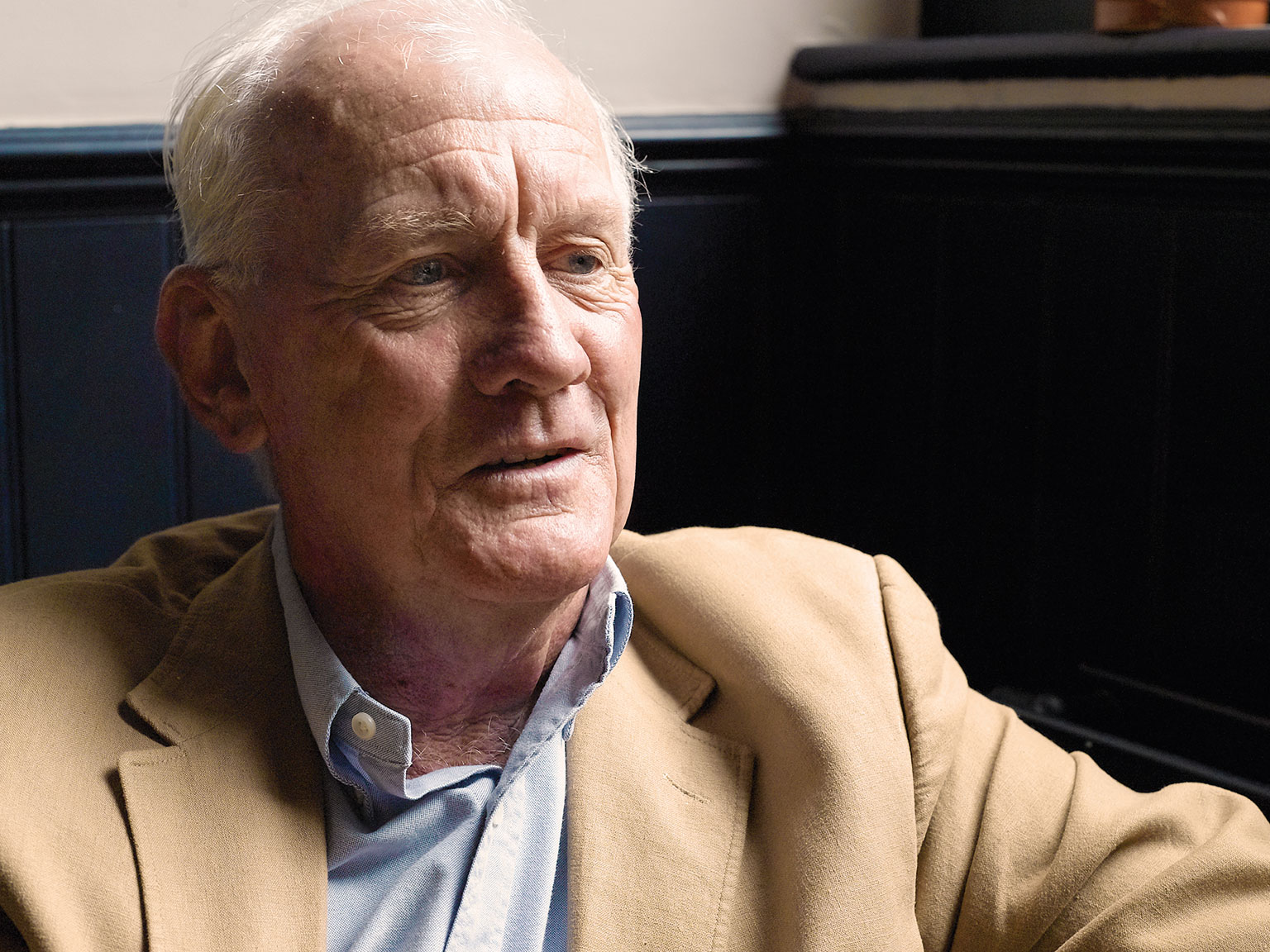
“Dudley Wood, who drove for us at Le Mans, was a lovely chap, but he had a terrible stammer. He’d come into the pits, you’d ask him how things were going, and all he’d say was, `Mmm… mmm.’ In qualifying he touched another car in the Mulsanne kink at 200mph and vaulted the guard rail. The car was in a terrible state, it was a miracle that he lived. His wife came back from the hospital all smiles. ‘How’s Dudley?’
‘Marvellous. He’s been near death in your car, and it’s cured his stammer.’ “At the end of 19861 was putting my own money in to keep the team alive, and the asset value was going down. I needed £3m to run two cars: doesn’t seem much now, but this was 25 years ago, and for that a sponsor could back a midfield Fl team and be on TV. It seemed the right time to get out. I sold everything — cars, transporter, tools, overalls — to Jochen Dauer in Germany. I built some houses in Spain, got a franchise for American golf carts there, and then because our two sons were at English schools we moved back to Sunningdale and I became BRDC secretary for seven years. It ruined my relationship with Tom Walkinshaw — it emerged he was using the club’s money to fund his own companies. In the aftermath of that there was a lot of animosity, and it split the club in half. Once the kids were at university Sandra and I went back to Spain.
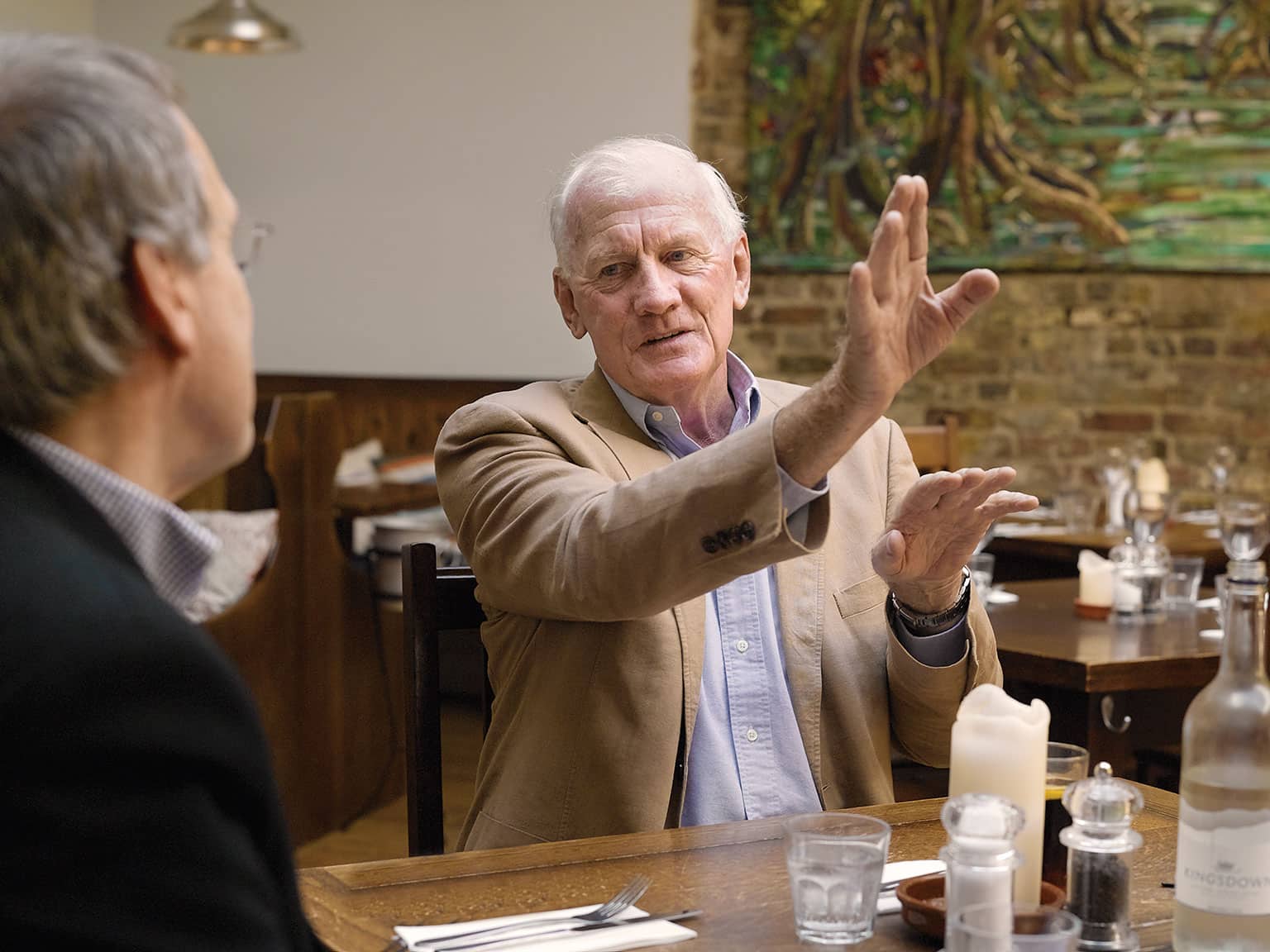
“More recently I’ve been fortunate to race histories at Goodwood and elsewhere, even at the Nurburgring: Ferrari 250GT, Lister-Jaguar, Porsche 904, D-type, Lotus 15.1 tell myself, Fitz, you’re 67, this is just meant to be fun. But when you get in the car you can’t help doing what you’ve always done, you go for it.” The flame that propelled the teenager round Brands in his Mini almost 50 years ago, and through the long nights at Le Mans and Daytona, burns still.
